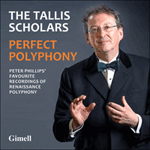If the
Missa De beata virgine is one of Josquin’s last works,
Missa Ave maris stella must be earlier, having been published by Petrucci in 1505. If one believes in the characteristics often ascribed to the middle-period works of creative artists, this setting illustrates many of them. Here is a Mass based throughout on a famous chant melody, building to three canons in each Agnus Dei. The writing everywhere is smooth and assured, giving the impression that Josquin was relaxing with techniques he had tried out before, in a more youthful way. His handling of the chant melody
Ave maris stella is a model of how to use motifs derived from a cantus firmus structurally over a long span. This is sometimes done in imitation, but the cross-references are so protean (one could almost say symphonic) that one comes away realizing there is little fat on these bones. My favourite piece of motivic tautness is the Amen of the Gloria. It only lasts nine bars but a whole world of perfection is there: the motif presented firstly as a duet, then a trio, then a pell-mell working in all four voices.
So tight is the compositional argument that the Agnus Dei canons are upon the listener before he realizes it. In this sense the whole setting might well be called a Missa Brevis. Strangely, it is only in the Sanctus that Josquin allowed himself to expand the style, with an unusually long trio at ‘pleni’, duets in the Benedictus and a big Hosanna. The Agnus then immediately carries one off into a different space, the central motif, which is well established by now, turning over and over on itself like the music of the spheres. This is surely Josquin at his most inventive and his most inspired.
from notes by Peter Phillips © 2011
Si la
Missa De beata virgine est l’une des dernières pièces de Josquin, la
Missa Ave maris stella doit lui être antérieure, puisque Petrucci la publia en 1505. Elle illustre bon nombre des caractéristiques souvent attribuées aux œuvres de la période centrale des artistes créateurs. Voilà une messe fondée de bout en bout sur une célèbre mélodie en plain-chant, atteignant trois canons dans chaque Agnus Dei. L’écriture, partout régulière et assurée, donne l’impression d’un Josquin plus détendu avec des techniques déjà expérimentées d’une manière plus juvénile. Son traitement de la mélodie en plain-chant
Ave maris stella est une façon modèle d’utiliser des motifs dérivés d’un cantus firmus, structurellement, sur un long intervalle. Ce qui se fait parfois en imitation, mais les références sont si protéiformes (on pourrait presque dire symphoniques) qu’on sort de là en comprenant que ces os sont bien maigres. Mon morceau de tension motivique préféré est l’Amen du Gloria. Il a beau durer seulement neuf mesures, il renferme tout un monde de perfection: le motif présenté successivement comme un duo, un trio et un pêle-mêle travaillant les quatre voix.
L’argument compositionnel est si serré que les canons de l’Agnus Dei sont sur l’auditeur avant même qu’il s’en rende compte. En ce sens, ce messe pourrait s’intituler Missa Brevis. Curieusement, c’est seulement dans le Sanctus que Josquin s’autorise un développement stylistique, avec un trio inhabituellement long à «pleni», des duos dans le Benedictus et un imposant Hosanna. Avec l’Agnus suivant, nous changeons d’emblée d’espace, le motif central, désormais bien établi, tournant sur lui-même encore et encore, pareil à la musique des sphères. Voilà assurément Josquin au plus inventif, au plus inspiré de lui-même.
extrait des notes rédigées par Peter Phillips © 2011
Français: Gimell
Wenn die
Missa De beata virgine eines der letzten Werke Josquins ist, dann muss die
Missa Ave maris stella ein früheres sein – sie wurde 1505 von Petrucci veröffentlicht. Wenn man die Charakteristika akzeptiert, die oft der mittleren Periode von schaffenden Künstlern zugeschrieben werden, so illustriert diese Vertonung eine ganze Reihe davon. Hierbei handelt es sich um eine Messe, der eine berühmte Cantus-planus-Melodie zugrunde liegt, die sich in beiden Agnus Deis zu drei Kanons entfaltet. Der Satz ist allgemein geschmeidig und sicher geführt, so dass man hier den Eindruck hat, als sei Josquin etwas gezügelter in seinem Umgang von Techniken, die er bereits zuvor, in jugendlicherer Art und Weise, erprobt hatte. Seine Behandlung der Cantus-planus-Melodie
Ave maris stella demonstriert vorbildlich, wie Motive, die einem Cantus firmus entstammen, über eine große Spannweite hinweg strukturell zu verarbeiten sind. Dies geschieht zuweilen in Imitation, doch sind die Querverweise derart vielgestaltig (man könnte fast sagen symphonisch), dass deutlich wird, dass auf diesen Knochen kaum Fett ist. Meine Lieblingsstelle, was die motivische Straffheit anbelangt, ist das Amen des Gloria. Es ist nur neun Takte lang, doch tut sich hier ein ganzes Spektrum der Perfektion auf: das Motiv wird zunächst als Duett präsentiert, dann als Trio und schließlich in einem Durcheinander, in dem alle vier Stimmen zum Einsatz kommen.
Der Satz ist derart dicht gearbeitet, dass die Agnus-Dei-Kanons beginnen, bevor der Hörer sich ihrer bewusst wird. In dem Sinne könnte diese Vertonung durchaus als Missa Brevis bezeichnet werden. Seltsamerweise erlaubt Josquin sich Erweiterungen seiner Anlage nur im Sanctus, und zwar mit einem ungewöhnlich langen Trio bei „pleni“, Duetten im Benedictus und einem großen Hosanna. Das Agnus Dei transportiert einen dann sofort in andere Gefilde und das zentrale Motiv, das inzwischen fest etabliert ist, dreht sich immer wieder um sich selbst wie die Sphärenmusik. Hier zeigt sich Josquin sicherlich von seiner phantasievollsten und inspiriertesten Seite.
aus dem Begleittext von Peter Phillips © 2011
Deutsch: Viola Scheffel





 Perfect Polyphony
Perfect Polyphony
